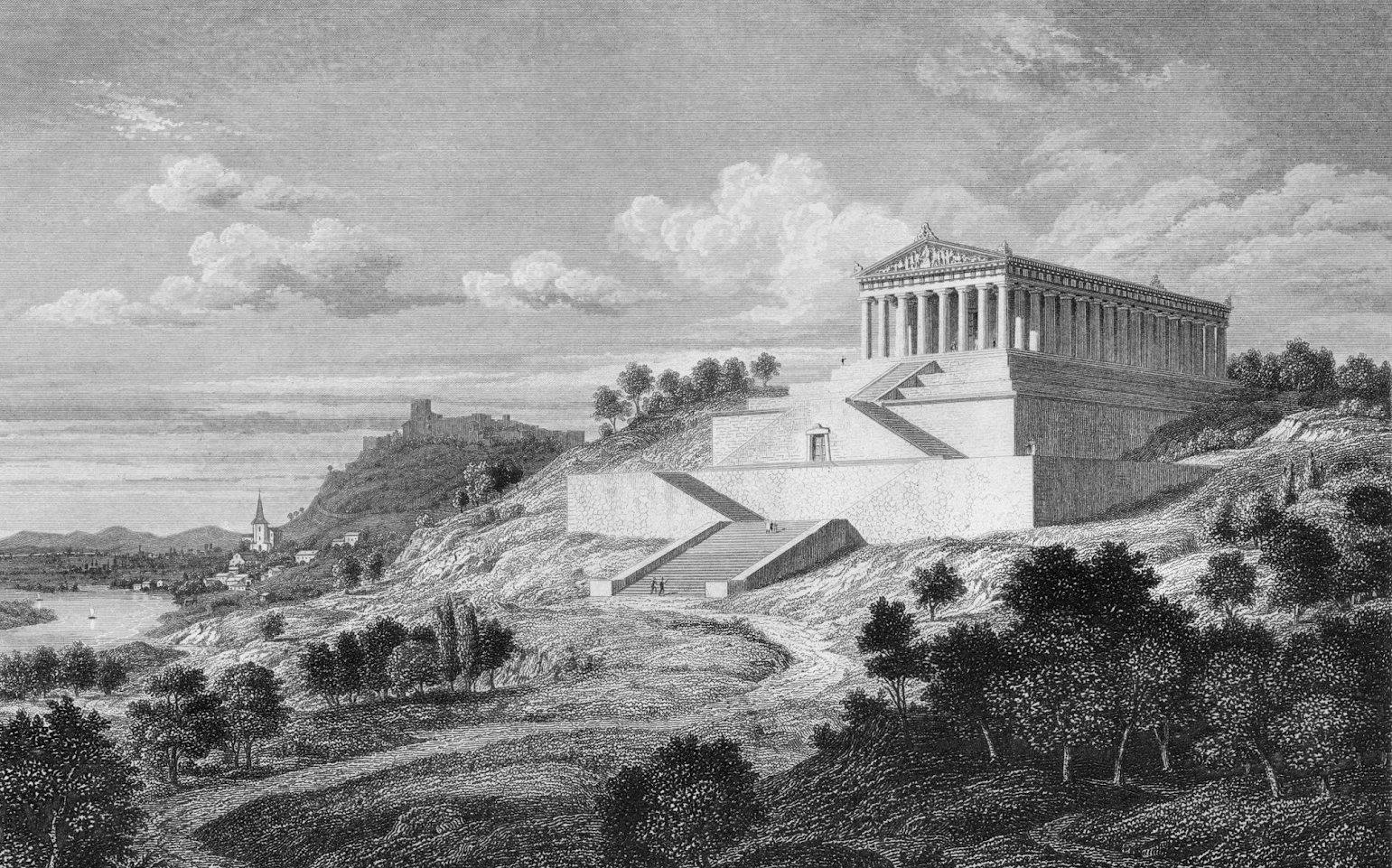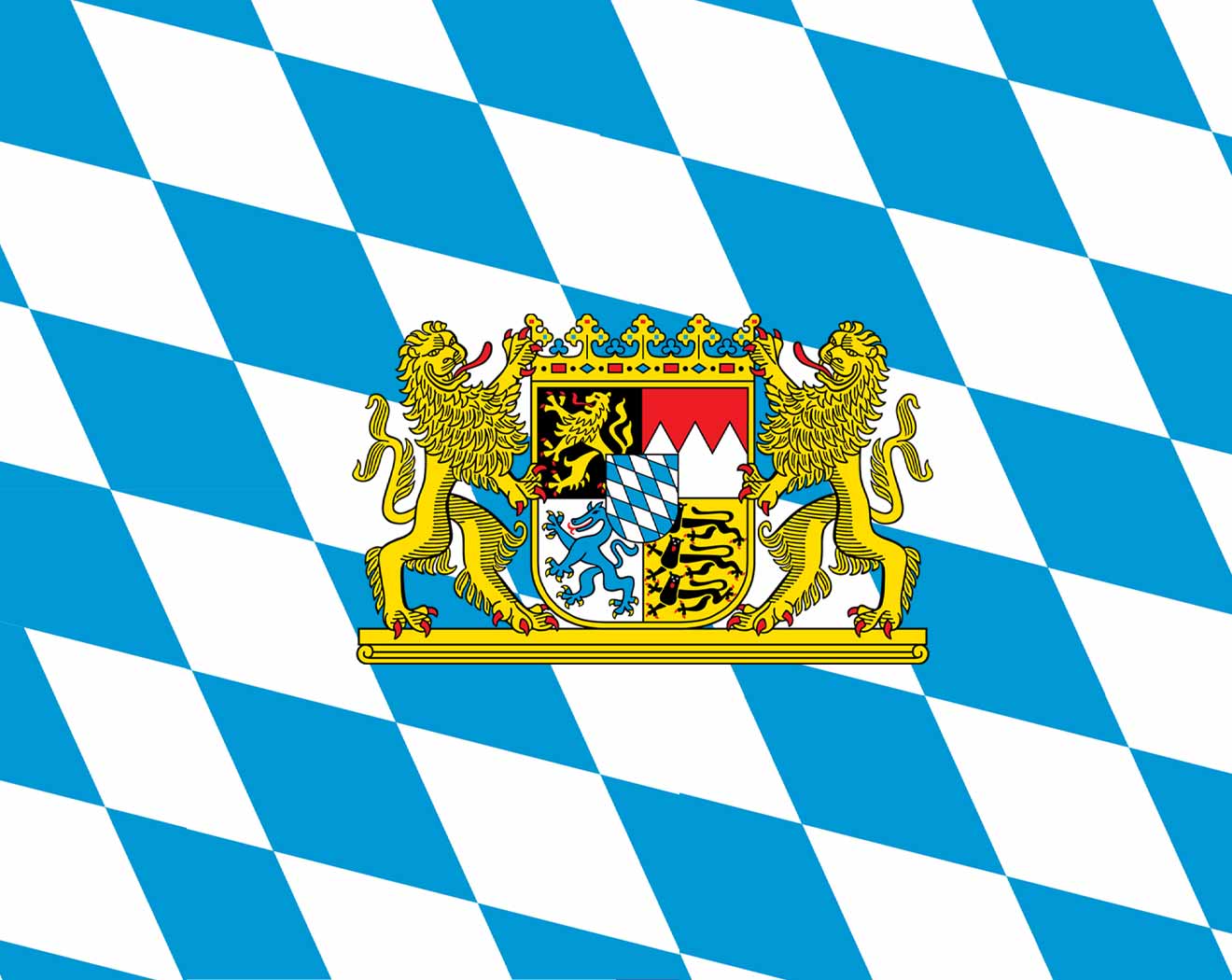

从雷根斯堡沿多瑙河向下游前行10公里,便到了瓦哈拉(Walhalla)。这座视野开阔的大理石神殿是19世纪在国王路德维希一世的主持下,由莱奥 (Leo)和克伦策(Klenze)按照多立克式的雅典神殿(Parthenon in Athen)的式样建造的。神殿内陈列着半身塑像,纪念德语地区的各重要人物。瓦尔哈拉神殿(Walhalla)是一座纪念“值得赞扬和尊敬的德国人”,包括“历史上说德语的著名人物 – 政治家、君主、科学家和艺术家”的名人堂[1],这是一座新古典主义建筑,位于德国巴伐利亚州雷根斯堡以东的多瑙河畔。1807年,巴伐利亚王储路德维希一世进行了构想,当他即位后,在1830年到1842年,由建筑师利奥·冯·克伦策修建。瓦尔哈拉神殿拥有65块牌匾和130人的半身像,覆盖2000年历史;最早的人物则是公元9年在条顿堡森林战役中获胜的阿米尼乌斯。
In der Gedenkstätte Walhalla in Donaustauf im bayerischen Landkreis Regensburg werden – ursprünglich auf Veranlassung des bayerischen Königs Ludwig I. – seit 1842 bedeutende Persönlichkeiten „teutscher Zunge“ mit Marmorbüsten und Gedenktafeln geehrt. Benannt ist sie nach Walhall, der Halle der Gefallenen in der nordischen Mythologie. Der Architekt war Leo von Klenze.
Zur Eröffnung im Jahre 1842 wurden 160 Personen mit 96 Büsten und, in den Fällen fehlender authentischer Abbildungen oder bei Handlungen wie dem Rütlischwur, 64 Gedenktafeln geehrt. Gegenwärtig umfasst die Sammlung 131 Büsten und 65 Gedenktafeln, die an Personen, Taten und Gruppen erinnern. 13 der Geehrten sind Frauen. Jedermann kann eine zu ehrende Persönlichkeit aus dem germanischen Sprachzweig frühestens 20 Jahre nach deren Tod vorschlagen und trägt dann gegebenenfalls die Kosten für die Anfertigung und Aufstellung der Büste. Über die Neuaufnahmen entscheidet der Bayerische Ministerrat.
ヴァルハラ神殿(ヴァルハラしんでん、Walhalla)は、「賞賛に値する著名なドイツ人」の殿堂である[1]。ドイツ語を母語とするドイツ史上の有名人、すなわち政治家、支配者、科学者、芸術家などを祭った、バイエルン州レーゲンスブルクの東のドナウ川岸の丘にある新古典主義の建築物である[1]。1807年、バイエルン王国の皇太子だったルートヴィヒ1世が構想し、建築家レオ・フォン・クレンツェが1830年から1842年に建設した。ヴァルハラ神殿はドイツの著名人について65枚の銘板と130体の胸像を収めており、2000年間のドイツの歴史を網羅している。祭られている最古の人物は、紀元9年にトイトブルク森の戦いに勝利したアルミニウスである。
The Walhalla is a hall of fame that honours laudable and distinguished people in German history – "politicians, sovereigns, scientists and artists of the German tongue";[1] thus the celebrities honoured are drawn from Greater Germany, a wider area than today's Germany, and even as far away as Britain in the case of several Anglo-Saxons who are honoured. The hall is a neo-classical building above the Danube River, in Donaustauf, east of Regensburg in Bavaria.
The Walhalla is named for the Valhalla of Norse Paganism. It was conceived in 1807 by Crown Prince Ludwig I of Bavaria in order to support the gathering momentum for the unification of the many German states. Following his accession to the throne of Bavaria, construction took place between 1830 and 1842 under the supervision of the architect Leo von Klenze. The memorial displays some 65 plaques and 130 busts covering 2,000 years of history, beginning with Arminius, victor at the Battle of the Teutoburg Forest in AD 9.
Le Walhalla est un temple néo-dorique en marbre situé à Donaustauf au bord du Danube, à 10 km en aval de Ratisbonne, en Bavière, Allemagne.
Il Walhalla è un tempio neoclassico ubicato a Donaustauf, nei pressi di Ratisbona, su una collina posta lungo le sponde del Danubio.
El Walhalla (del alemán Walhalla y este del nórdico antiguo Valhöll; lit. ‘salón de los caídos’) es un imponente templo neoclásico cuyo propósito es servir de monumento y salón de la fama a «alemanes laureados y distinguidos». Se levantó a orillas del río Danubio a seis kilómetros hacia el este de Ratisbona, en Baviera, Alemania.[cita requerida]
Fue concebido por el Rey Luis I de Baviera (el abuelo de Luis II) y construido entre 1830 y 1842 bajo diseños de Leo von Klenze, que también fue responsable del Befreiungshalle, también cerca de Ratisbona sobre el Danubio. El Walhalla debe su nombre al salón de los dioses de la mitología germánica (y nórdica) siendo el equivalente al Olimpo griego. Es una copia perfecta del Partenón de Atenas, sostenido por 52 columnas dóricas.1En su interior alberga unas 65 placas y bustos de 130 personas ilustres cubriendo 2000 años de historia. El más antiguo es Arminio, victorioso en la Batalla del bosque de Teutoburgo en el año 9 d. C.
Fue concebido en 1807 por el príncipe heredero Luis I de Baviera con el fin de respaldar el impulso que se estaba acumulando para la unificación de los muchos estados alemanes. Tras su ascenso al trono de Baviera, la construcción se llevó a cabo entre 1830 y 1842 bajo la supervisión del arquitecto Leo von Klenze.
Mientras que el Valhalla de la Mitología nórdica sirvió como hogar para aquellos gloriosamente muertos en batalla, Ludwig pretendía que su Walhalla no solo fuera para guerreros sino también para científicos, escritores y clérigos, y específicamente incluía tanto a hombres como a mujeres. Décadas antes de la fundación del Estado alemán moderno en 1871, "Alemán" se entendía como "germánico", e incluía antiguos germánicos (gótico, vándalo, lombardos, anglosajón) así como medieval y moderno austriaco, holandés, sueco y suizo cifras.
Вальха́лла (нем. Walhalla) — зал славы выдающихся исторических личностей, принадлежащих к германской культуре, расположенный на высоком левом берегу Дуная в 10 км к востоку от города Регенсбурга (Бавария, Германия). Согласно скандинавской и немецкой мифологиям Вальхалла — место посмертного обитания павших в битве героев, доставляемых туда воинственными девами — Валькириями. Здание в неогреческом стиле, повторяющее в общих чертах архитектуру Парфенона афинского Акрополя, построено архитектором Лео фон Кленце, известным в России возведением здания Нового Эрмитажа в Санкт-Петербурге. Размеры Вальхаллы почти совпадают с размерами Парфенона. Его длина составляет 48,5 м, ширина — 14 м и высота — 15,5 м. Как и Парфенон, германский монумент имеет 8 х 17 колонн дорического ордера по главному и боковым фасадам[1]









 Bavaria
Bavaria
 Museum
Museum
 Vacation and Travel
Vacation and Travel



